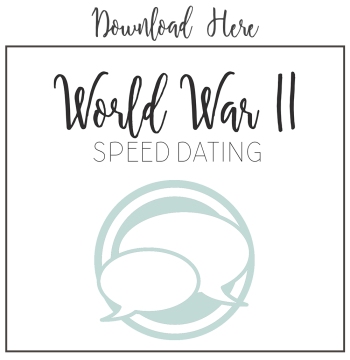Although I absolutely love teaching American Literature, one challenge I find is that students have heard so much about certain periods in American history, that they find those topics boring. Unfortunately, they don’t necessarily have all of the background knowledge they need to understand the literature written at that time. One such topic is World War II. While many students are familiar with some specific details, I often discover that they don’t really understand how all of the different components of the war connect. Based on a technique I had the opportunity to observe in a U.S. History class, I have developed an activity to help provide students with important background knowledge in an an informative yet engaging way!
Speed dating! If you haven’t used this method before, the basic concept is that each student is assigned a specific person or event relating to the topic. It is their job to become informed enough about the topic so that they can teach about it to others. Once students complete their research, we have a “speed dating” day, in which they sit across from a partner, exchange information about their topic, learn about their partner’s topic, and then rotate to the next partner to do the same until they have learned about each topic in the series. Because I typically use this as an introductory activity, I only spend two days on it – Day 1 for research and Day 2 for speed dating.
Although the actual activity itself is relatively straightforward, the most challenging aspect is the preparation involved to make sure it runs smoothly. Here is how I typically plan for it:
- First, I develop a list of key terms and topics relating to World War II and questions for each one to guide students’ research. (You can download my handouts and answer key here!)
- Next, I allow students to choose their topic so they will be more motivated and engaged in their research. I typically count how many students are in the class period and put on the board a list of half the amount of topics as there are students. (For example, if there are 24 students in the class, I list 12 topics.) . Then I randomly call students 1 by 1 to choose their topic so that there will be 2 students assigned to each topic. Before this, I have already made 2 copies of each topic handout with questions and distribute them to students as they select.
- Then I provide the rest of the class period for students to conduct research. I usually bring a stack of books from my campus library and also allow them to use their phones/computers. Whatever they don’t finish in class is homework.
- The following day is Speed Dating Day! I prepare by putting desks in pairs facing each other in a semi-circle pattern (below). The key is to ensure that each topic is represented in the outer circle and in the inner circle. In the past I have written an A or a B on each of the two copies of handouts so that I can just instruct students with an A to sit on the inside and students with a B to sit on the outside. Other ideas might be to highlight the handouts with 2 different colors or print each set on a different color paper.

- When students come in the following day, I give them a few minutes to make sure they have completed their research. I also ask students to write 2 high-level questions about WWII based on their topic. Some possible sentence stems include:
- Why do you think…?
- How would _____ be different if….?
- Why might…?
- Finally, it is time for students to “date!” The amount of time you give students with each partner will depend on the number of students in the class and how long your class period is. I typically divide the number of minutes by the number of partners and use that as my timer (3-4 minutes is usually enough time). I put a timer on the board so that students can be aware of how much time they have to make sure that both partners get to share their information. Students sometimes struggle to get the timing right the first few times, but pretty quickly are able to adapt. I created a blank handout with the list of topics so that students will take notes on their partner’s topic as they share. This helps keep them focused as well! If students finish sharing before the time is up, I ask that they share the questions they developed in at the beginning of class and discuss them together. Once the time is up, the inside circle rotates to meet with the next partner. By the end of the session, all students should have had an opportunity to take notes on all topics.
- At the end of the period, I like to end with a short discussion and some reflection questions, such as:
- Did you learn/remember anything interesting?
- What stands out to you about the WWII era?
- Why, after the devastation of World War I, did Americans choose to enter WWII?
- Finally, I combine all aspects of the assignments into one grade: their research, their high-level questions, and their notes during the speed dating session.
I have found that students really enjoy this activity, and it is a great way to review/introduce information in a short amount of time! Have you ever tried a speed dating activity? How did you use it?
Click below to download all of the handouts and resources mentioned in this post!


